Project Management Case Study: Oil Company Tank Repair Project
VerifiedAdded on 2023/06/08
|11
|1843
|50
Report
AI Summary
This report presents a case study on the project management practices of a multinational oil company undertaking fuel tank repairs at a Western Australian site. The project aims to prevent environmental fines, increase fuel tank availability, and ensure project completion within budget and schedule. The report details the development of project goals, scope definition (including in-scope and out-of-scope elements), stakeholder analysis, and project deliverables. It also outlines the project's methodology, which utilizes an agile approach, and describes methods for monitoring, controlling, and measuring project success, including schedule control, quality control, and risk management. The report analyzes the project phases, the responsibilities of various stakeholders, and the criteria used to determine project acceptance and success, such as reduced fines and increased tank availability. Finally, it provides a bibliography of relevant project management literature.

Running head: PROJECT MANAGEMENT
Case Study: Multinational Oil company
Name of the Student
Name of the University
Author’s Note
Case Study: Multinational Oil company
Name of the Student
Name of the University
Author’s Note
Paraphrase This Document
Need a fresh take? Get an instant paraphrase of this document with our AI Paraphraser
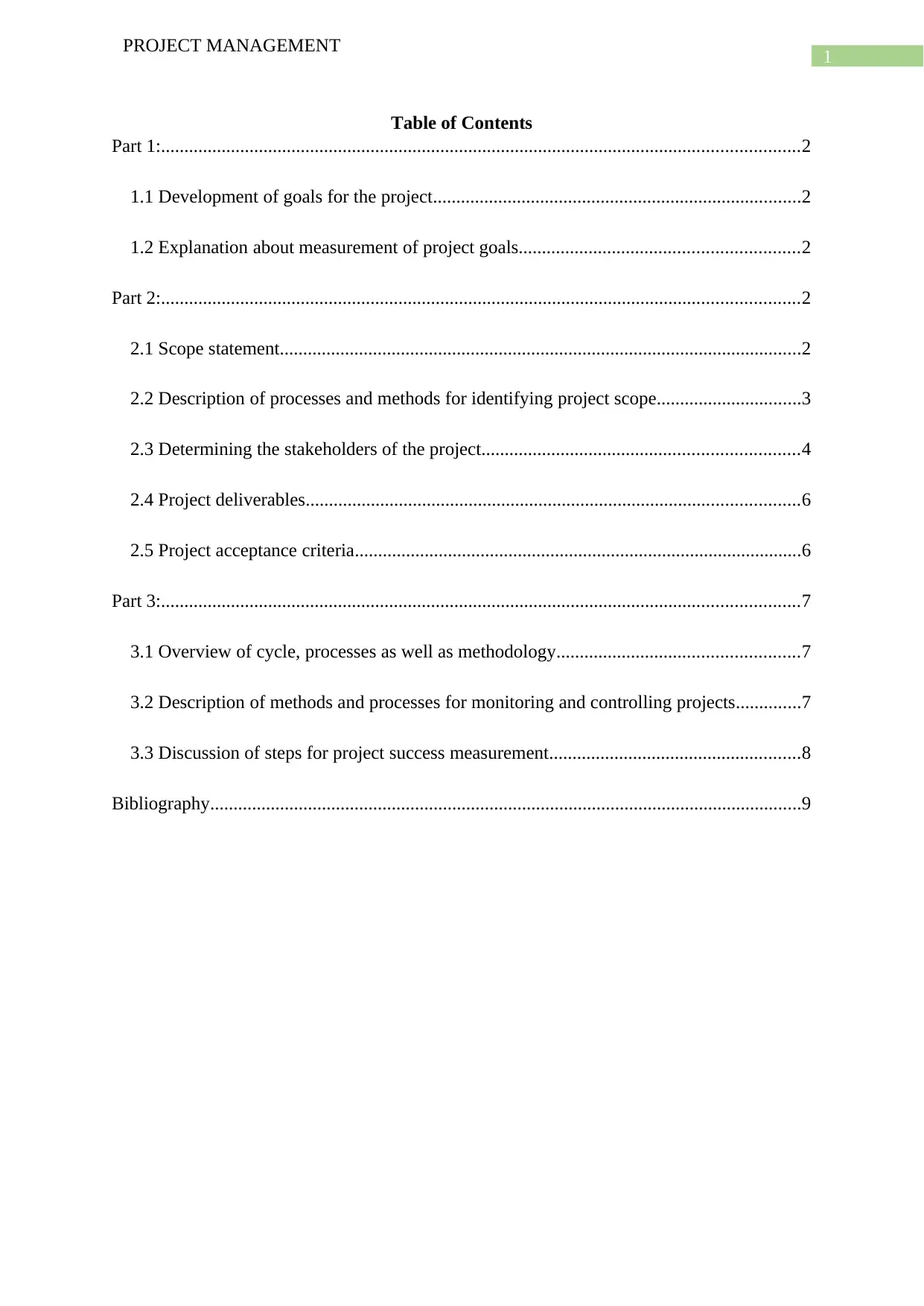
1
PROJECT MANAGEMENT
Table of Contents
Part 1:.........................................................................................................................................2
1.1 Development of goals for the project...............................................................................2
1.2 Explanation about measurement of project goals............................................................2
Part 2:.........................................................................................................................................2
2.1 Scope statement................................................................................................................2
2.2 Description of processes and methods for identifying project scope...............................3
2.3 Determining the stakeholders of the project....................................................................4
2.4 Project deliverables..........................................................................................................6
2.5 Project acceptance criteria................................................................................................6
Part 3:.........................................................................................................................................7
3.1 Overview of cycle, processes as well as methodology....................................................7
3.2 Description of methods and processes for monitoring and controlling projects..............7
3.3 Discussion of steps for project success measurement......................................................8
Bibliography...............................................................................................................................9
PROJECT MANAGEMENT
Table of Contents
Part 1:.........................................................................................................................................2
1.1 Development of goals for the project...............................................................................2
1.2 Explanation about measurement of project goals............................................................2
Part 2:.........................................................................................................................................2
2.1 Scope statement................................................................................................................2
2.2 Description of processes and methods for identifying project scope...............................3
2.3 Determining the stakeholders of the project....................................................................4
2.4 Project deliverables..........................................................................................................6
2.5 Project acceptance criteria................................................................................................6
Part 3:.........................................................................................................................................7
3.1 Overview of cycle, processes as well as methodology....................................................7
3.2 Description of methods and processes for monitoring and controlling projects..............7
3.3 Discussion of steps for project success measurement......................................................8
Bibliography...............................................................................................................................9
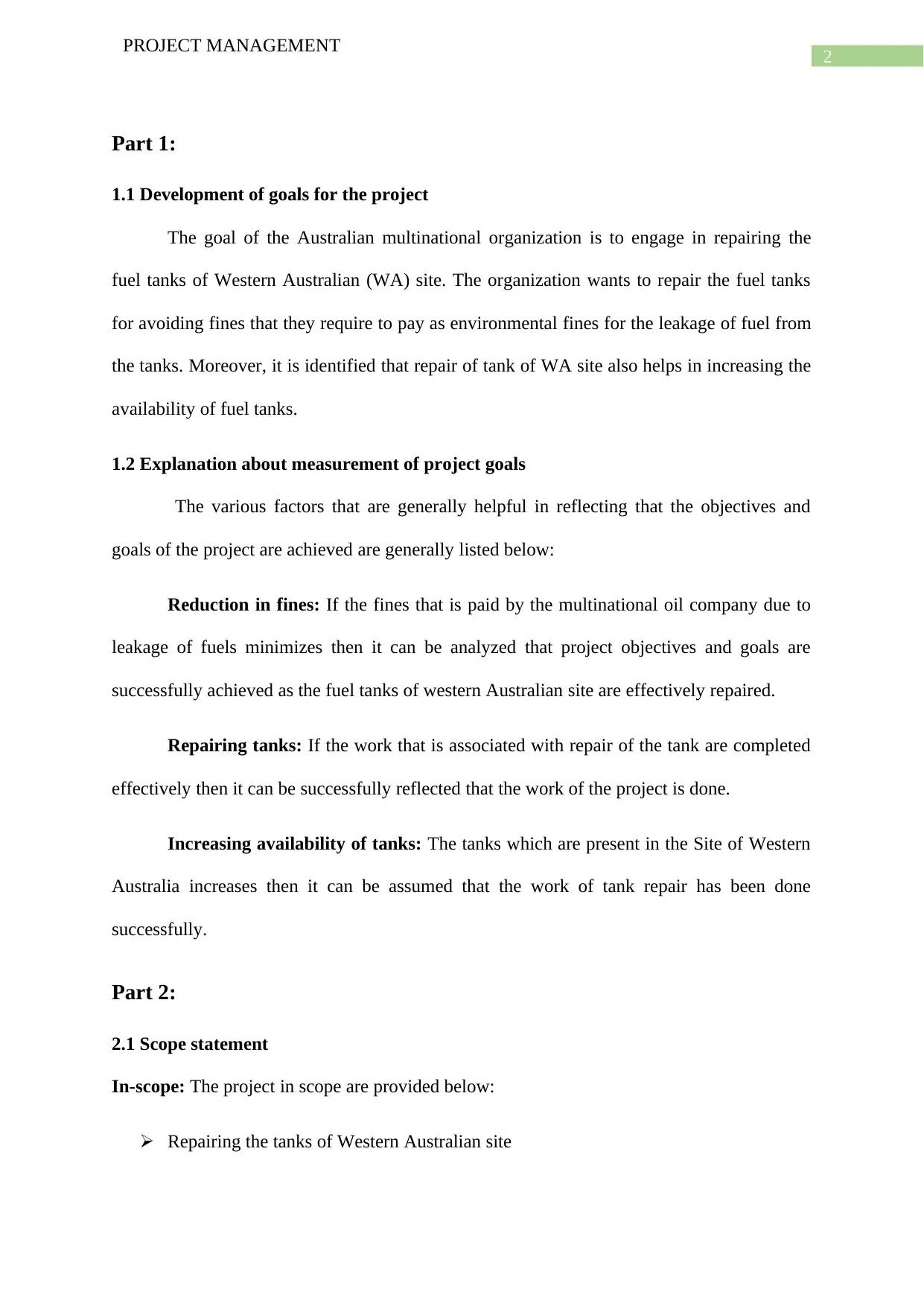
2
PROJECT MANAGEMENT
Part 1:
1.1 Development of goals for the project
The goal of the Australian multinational organization is to engage in repairing the
fuel tanks of Western Australian (WA) site. The organization wants to repair the fuel tanks
for avoiding fines that they require to pay as environmental fines for the leakage of fuel from
the tanks. Moreover, it is identified that repair of tank of WA site also helps in increasing the
availability of fuel tanks.
1.2 Explanation about measurement of project goals
The various factors that are generally helpful in reflecting that the objectives and
goals of the project are achieved are generally listed below:
Reduction in fines: If the fines that is paid by the multinational oil company due to
leakage of fuels minimizes then it can be analyzed that project objectives and goals are
successfully achieved as the fuel tanks of western Australian site are effectively repaired.
Repairing tanks: If the work that is associated with repair of the tank are completed
effectively then it can be successfully reflected that the work of the project is done.
Increasing availability of tanks: The tanks which are present in the Site of Western
Australia increases then it can be assumed that the work of tank repair has been done
successfully.
Part 2:
2.1 Scope statement
In-scope: The project in scope are provided below:
Repairing the tanks of Western Australian site
PROJECT MANAGEMENT
Part 1:
1.1 Development of goals for the project
The goal of the Australian multinational organization is to engage in repairing the
fuel tanks of Western Australian (WA) site. The organization wants to repair the fuel tanks
for avoiding fines that they require to pay as environmental fines for the leakage of fuel from
the tanks. Moreover, it is identified that repair of tank of WA site also helps in increasing the
availability of fuel tanks.
1.2 Explanation about measurement of project goals
The various factors that are generally helpful in reflecting that the objectives and
goals of the project are achieved are generally listed below:
Reduction in fines: If the fines that is paid by the multinational oil company due to
leakage of fuels minimizes then it can be analyzed that project objectives and goals are
successfully achieved as the fuel tanks of western Australian site are effectively repaired.
Repairing tanks: If the work that is associated with repair of the tank are completed
effectively then it can be successfully reflected that the work of the project is done.
Increasing availability of tanks: The tanks which are present in the Site of Western
Australia increases then it can be assumed that the work of tank repair has been done
successfully.
Part 2:
2.1 Scope statement
In-scope: The project in scope are provided below:
Repairing the tanks of Western Australian site
⊘ This is a preview!⊘
Do you want full access?
Subscribe today to unlock all pages.

Trusted by 1+ million students worldwide
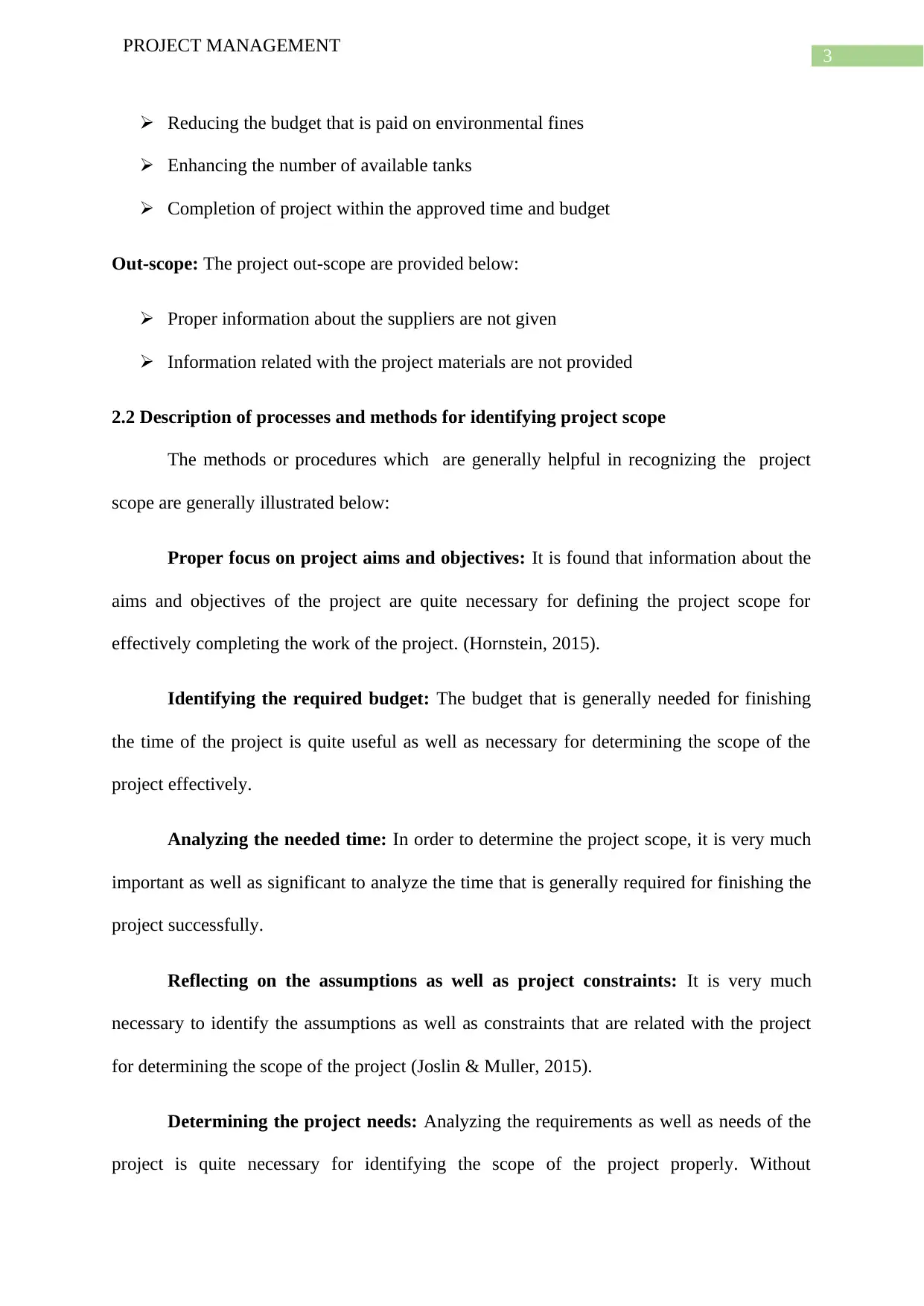
3
PROJECT MANAGEMENT
Reducing the budget that is paid on environmental fines
Enhancing the number of available tanks
Completion of project within the approved time and budget
Out-scope: The project out-scope are provided below:
Proper information about the suppliers are not given
Information related with the project materials are not provided
2.2 Description of processes and methods for identifying project scope
The methods or procedures which are generally helpful in recognizing the project
scope are generally illustrated below:
Proper focus on project aims and objectives: It is found that information about the
aims and objectives of the project are quite necessary for defining the project scope for
effectively completing the work of the project. (Hornstein, 2015).
Identifying the required budget: The budget that is generally needed for finishing
the time of the project is quite useful as well as necessary for determining the scope of the
project effectively.
Analyzing the needed time: In order to determine the project scope, it is very much
important as well as significant to analyze the time that is generally required for finishing the
project successfully.
Reflecting on the assumptions as well as project constraints: It is very much
necessary to identify the assumptions as well as constraints that are related with the project
for determining the scope of the project (Joslin & Muller, 2015).
Determining the project needs: Analyzing the requirements as well as needs of the
project is quite necessary for identifying the scope of the project properly. Without
PROJECT MANAGEMENT
Reducing the budget that is paid on environmental fines
Enhancing the number of available tanks
Completion of project within the approved time and budget
Out-scope: The project out-scope are provided below:
Proper information about the suppliers are not given
Information related with the project materials are not provided
2.2 Description of processes and methods for identifying project scope
The methods or procedures which are generally helpful in recognizing the project
scope are generally illustrated below:
Proper focus on project aims and objectives: It is found that information about the
aims and objectives of the project are quite necessary for defining the project scope for
effectively completing the work of the project. (Hornstein, 2015).
Identifying the required budget: The budget that is generally needed for finishing
the time of the project is quite useful as well as necessary for determining the scope of the
project effectively.
Analyzing the needed time: In order to determine the project scope, it is very much
important as well as significant to analyze the time that is generally required for finishing the
project successfully.
Reflecting on the assumptions as well as project constraints: It is very much
necessary to identify the assumptions as well as constraints that are related with the project
for determining the scope of the project (Joslin & Muller, 2015).
Determining the project needs: Analyzing the requirements as well as needs of the
project is quite necessary for identifying the scope of the project properly. Without
Paraphrase This Document
Need a fresh take? Get an instant paraphrase of this document with our AI Paraphraser
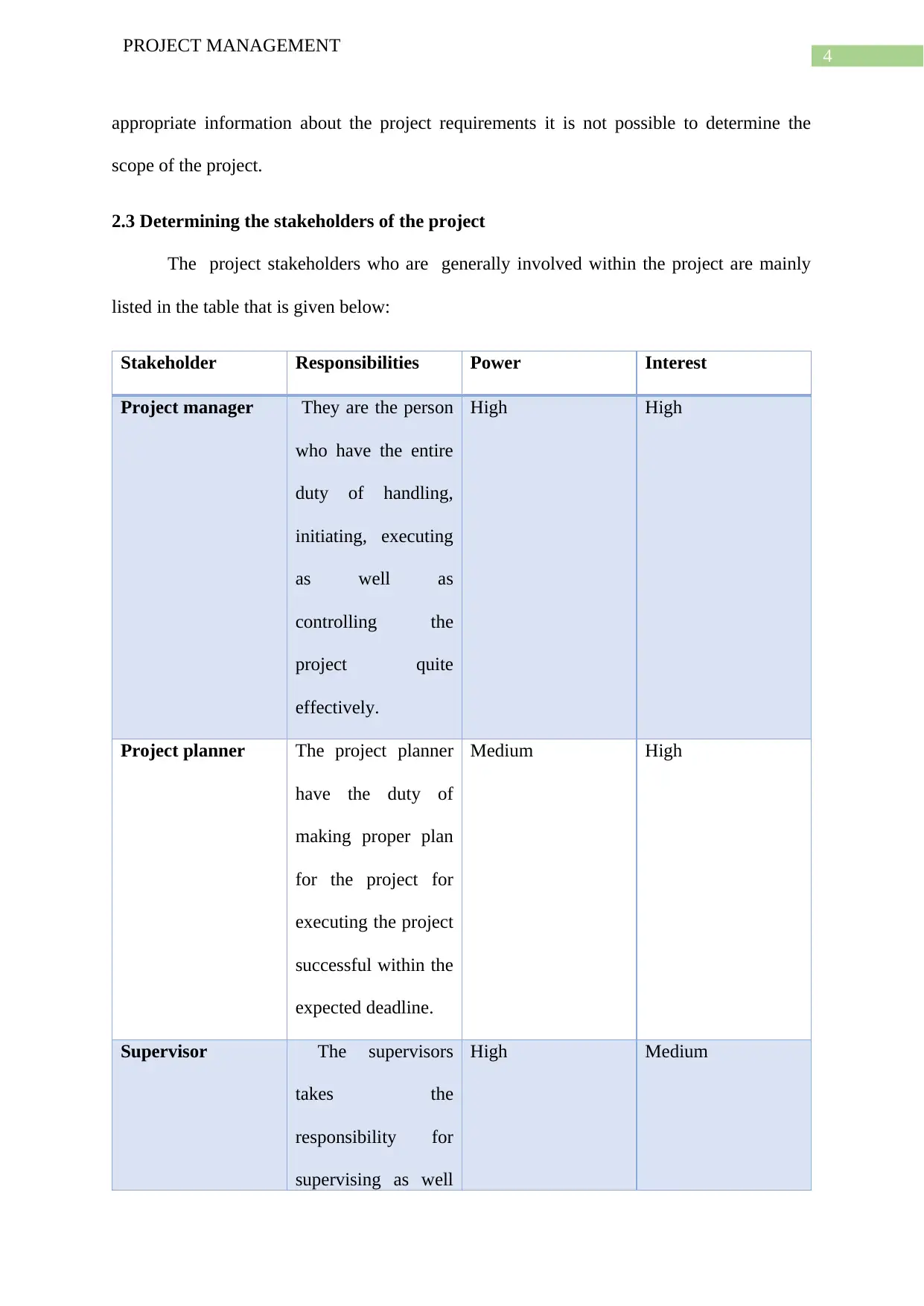
4
PROJECT MANAGEMENT
appropriate information about the project requirements it is not possible to determine the
scope of the project.
2.3 Determining the stakeholders of the project
The project stakeholders who are generally involved within the project are mainly
listed in the table that is given below:
Stakeholder Responsibilities Power Interest
Project manager They are the person
who have the entire
duty of handling,
initiating, executing
as well as
controlling the
project quite
effectively.
High High
Project planner The project planner
have the duty of
making proper plan
for the project for
executing the project
successful within the
expected deadline.
Medium High
Supervisor The supervisors
takes the
responsibility for
supervising as well
High Medium
PROJECT MANAGEMENT
appropriate information about the project requirements it is not possible to determine the
scope of the project.
2.3 Determining the stakeholders of the project
The project stakeholders who are generally involved within the project are mainly
listed in the table that is given below:
Stakeholder Responsibilities Power Interest
Project manager They are the person
who have the entire
duty of handling,
initiating, executing
as well as
controlling the
project quite
effectively.
High High
Project planner The project planner
have the duty of
making proper plan
for the project for
executing the project
successful within the
expected deadline.
Medium High
Supervisor The supervisors
takes the
responsibility for
supervising as well
High Medium
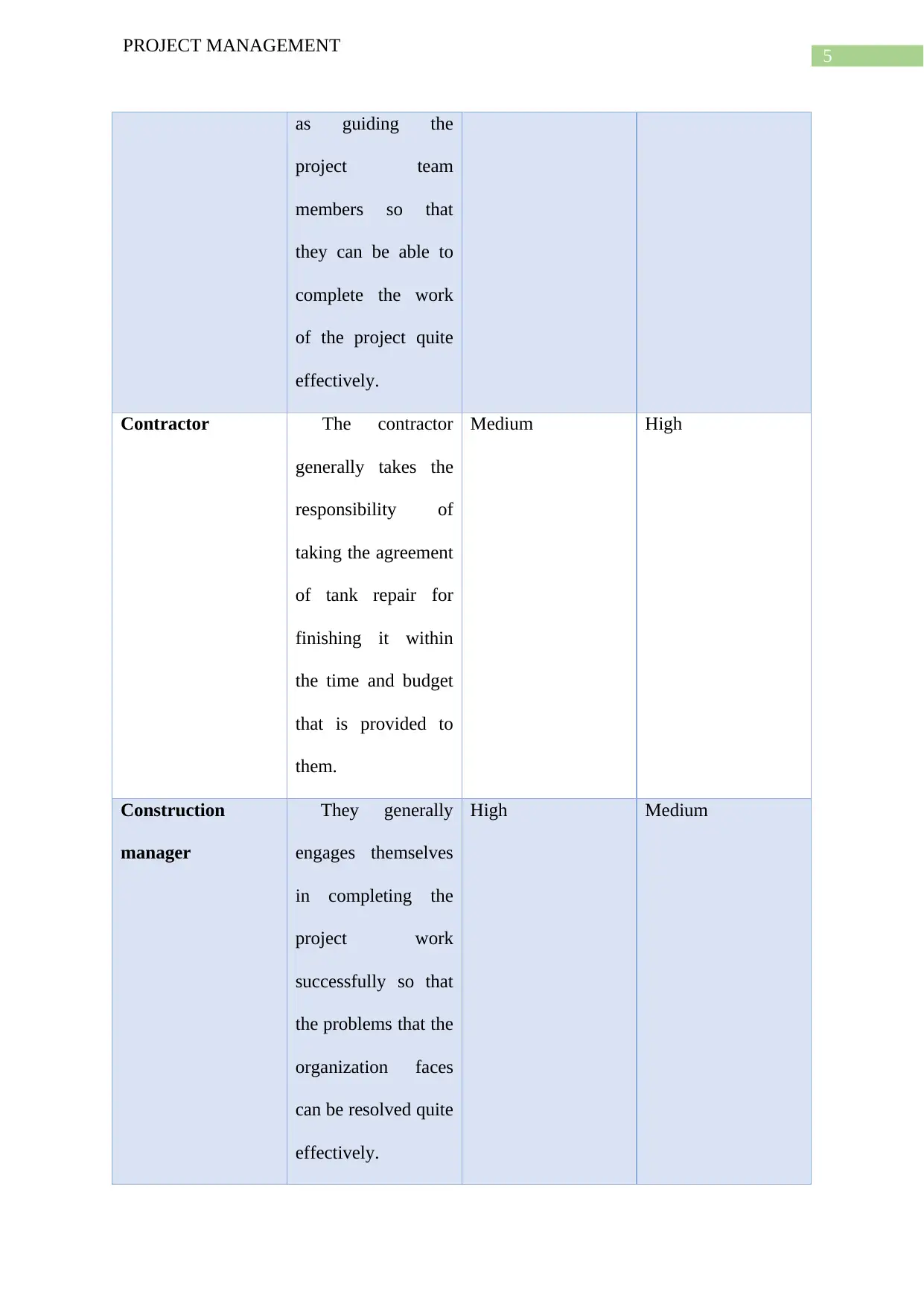
5
PROJECT MANAGEMENT
as guiding the
project team
members so that
they can be able to
complete the work
of the project quite
effectively.
Contractor The contractor
generally takes the
responsibility of
taking the agreement
of tank repair for
finishing it within
the time and budget
that is provided to
them.
Medium High
Construction
manager
They generally
engages themselves
in completing the
project work
successfully so that
the problems that the
organization faces
can be resolved quite
effectively.
High Medium
PROJECT MANAGEMENT
as guiding the
project team
members so that
they can be able to
complete the work
of the project quite
effectively.
Contractor The contractor
generally takes the
responsibility of
taking the agreement
of tank repair for
finishing it within
the time and budget
that is provided to
them.
Medium High
Construction
manager
They generally
engages themselves
in completing the
project work
successfully so that
the problems that the
organization faces
can be resolved quite
effectively.
High Medium
⊘ This is a preview!⊘
Do you want full access?
Subscribe today to unlock all pages.

Trusted by 1+ million students worldwide
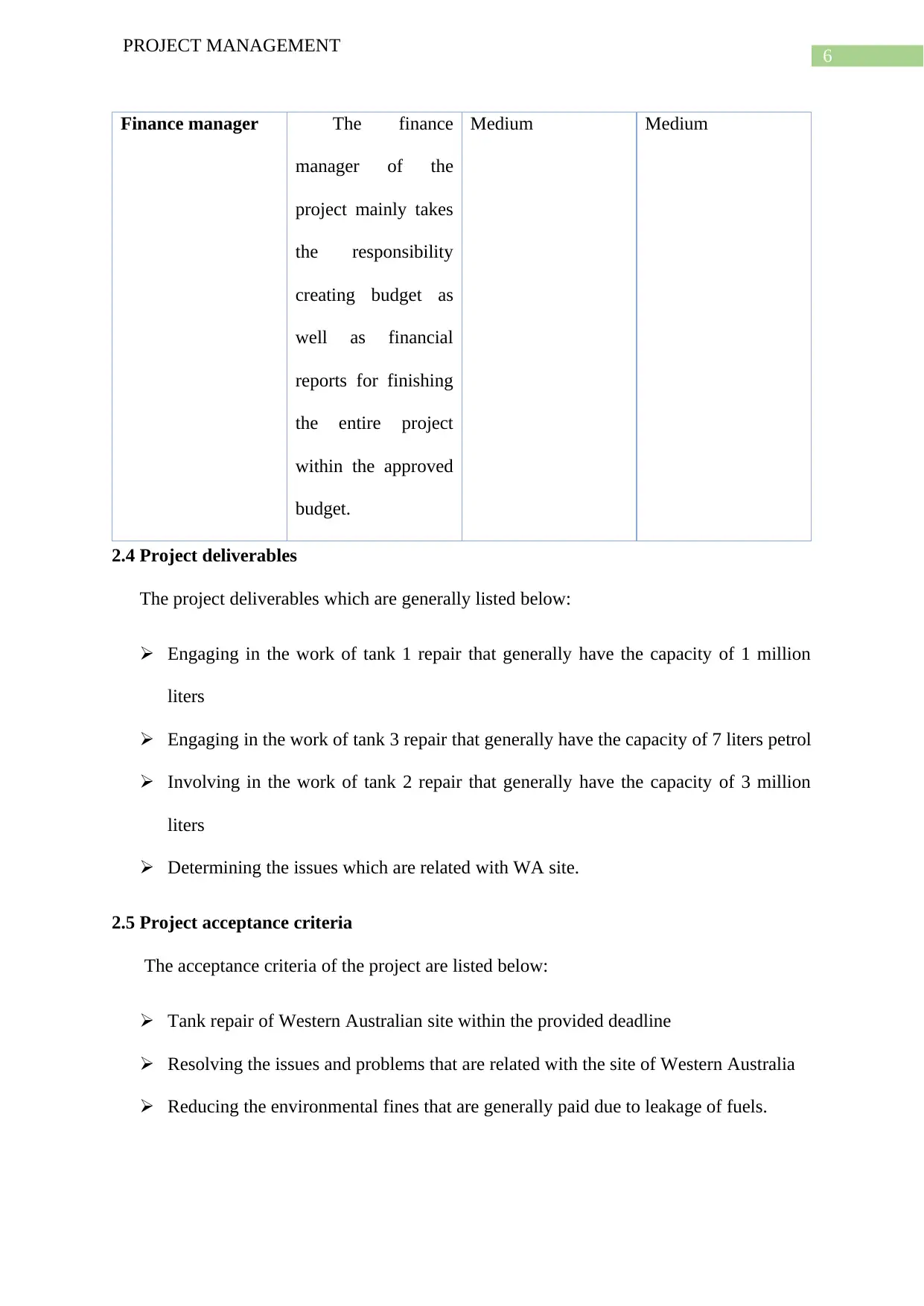
6
PROJECT MANAGEMENT
Finance manager The finance
manager of the
project mainly takes
the responsibility
creating budget as
well as financial
reports for finishing
the entire project
within the approved
budget.
Medium Medium
2.4 Project deliverables
The project deliverables which are generally listed below:
Engaging in the work of tank 1 repair that generally have the capacity of 1 million
liters
Engaging in the work of tank 3 repair that generally have the capacity of 7 liters petrol
Involving in the work of tank 2 repair that generally have the capacity of 3 million
liters
Determining the issues which are related with WA site.
2.5 Project acceptance criteria
The acceptance criteria of the project are listed below:
Tank repair of Western Australian site within the provided deadline
Resolving the issues and problems that are related with the site of Western Australia
Reducing the environmental fines that are generally paid due to leakage of fuels.
PROJECT MANAGEMENT
Finance manager The finance
manager of the
project mainly takes
the responsibility
creating budget as
well as financial
reports for finishing
the entire project
within the approved
budget.
Medium Medium
2.4 Project deliverables
The project deliverables which are generally listed below:
Engaging in the work of tank 1 repair that generally have the capacity of 1 million
liters
Engaging in the work of tank 3 repair that generally have the capacity of 7 liters petrol
Involving in the work of tank 2 repair that generally have the capacity of 3 million
liters
Determining the issues which are related with WA site.
2.5 Project acceptance criteria
The acceptance criteria of the project are listed below:
Tank repair of Western Australian site within the provided deadline
Resolving the issues and problems that are related with the site of Western Australia
Reducing the environmental fines that are generally paid due to leakage of fuels.
Paraphrase This Document
Need a fresh take? Get an instant paraphrase of this document with our AI Paraphraser
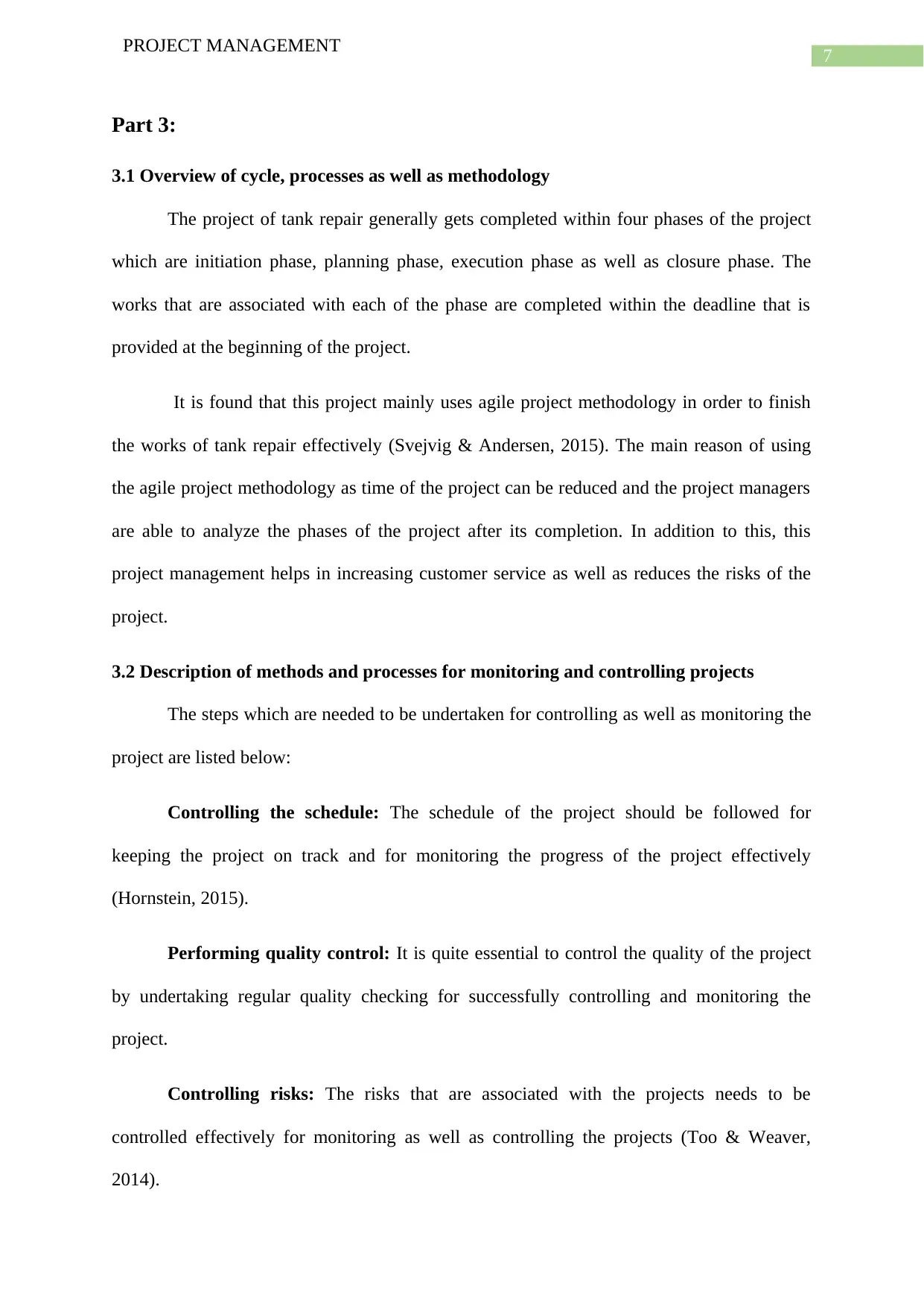
7
PROJECT MANAGEMENT
Part 3:
3.1 Overview of cycle, processes as well as methodology
The project of tank repair generally gets completed within four phases of the project
which are initiation phase, planning phase, execution phase as well as closure phase. The
works that are associated with each of the phase are completed within the deadline that is
provided at the beginning of the project.
It is found that this project mainly uses agile project methodology in order to finish
the works of tank repair effectively (Svejvig & Andersen, 2015). The main reason of using
the agile project methodology as time of the project can be reduced and the project managers
are able to analyze the phases of the project after its completion. In addition to this, this
project management helps in increasing customer service as well as reduces the risks of the
project.
3.2 Description of methods and processes for monitoring and controlling projects
The steps which are needed to be undertaken for controlling as well as monitoring the
project are listed below:
Controlling the schedule: The schedule of the project should be followed for
keeping the project on track and for monitoring the progress of the project effectively
(Hornstein, 2015).
Performing quality control: It is quite essential to control the quality of the project
by undertaking regular quality checking for successfully controlling and monitoring the
project.
Controlling risks: The risks that are associated with the projects needs to be
controlled effectively for monitoring as well as controlling the projects (Too & Weaver,
2014).
PROJECT MANAGEMENT
Part 3:
3.1 Overview of cycle, processes as well as methodology
The project of tank repair generally gets completed within four phases of the project
which are initiation phase, planning phase, execution phase as well as closure phase. The
works that are associated with each of the phase are completed within the deadline that is
provided at the beginning of the project.
It is found that this project mainly uses agile project methodology in order to finish
the works of tank repair effectively (Svejvig & Andersen, 2015). The main reason of using
the agile project methodology as time of the project can be reduced and the project managers
are able to analyze the phases of the project after its completion. In addition to this, this
project management helps in increasing customer service as well as reduces the risks of the
project.
3.2 Description of methods and processes for monitoring and controlling projects
The steps which are needed to be undertaken for controlling as well as monitoring the
project are listed below:
Controlling the schedule: The schedule of the project should be followed for
keeping the project on track and for monitoring the progress of the project effectively
(Hornstein, 2015).
Performing quality control: It is quite essential to control the quality of the project
by undertaking regular quality checking for successfully controlling and monitoring the
project.
Controlling risks: The risks that are associated with the projects needs to be
controlled effectively for monitoring as well as controlling the projects (Too & Weaver,
2014).
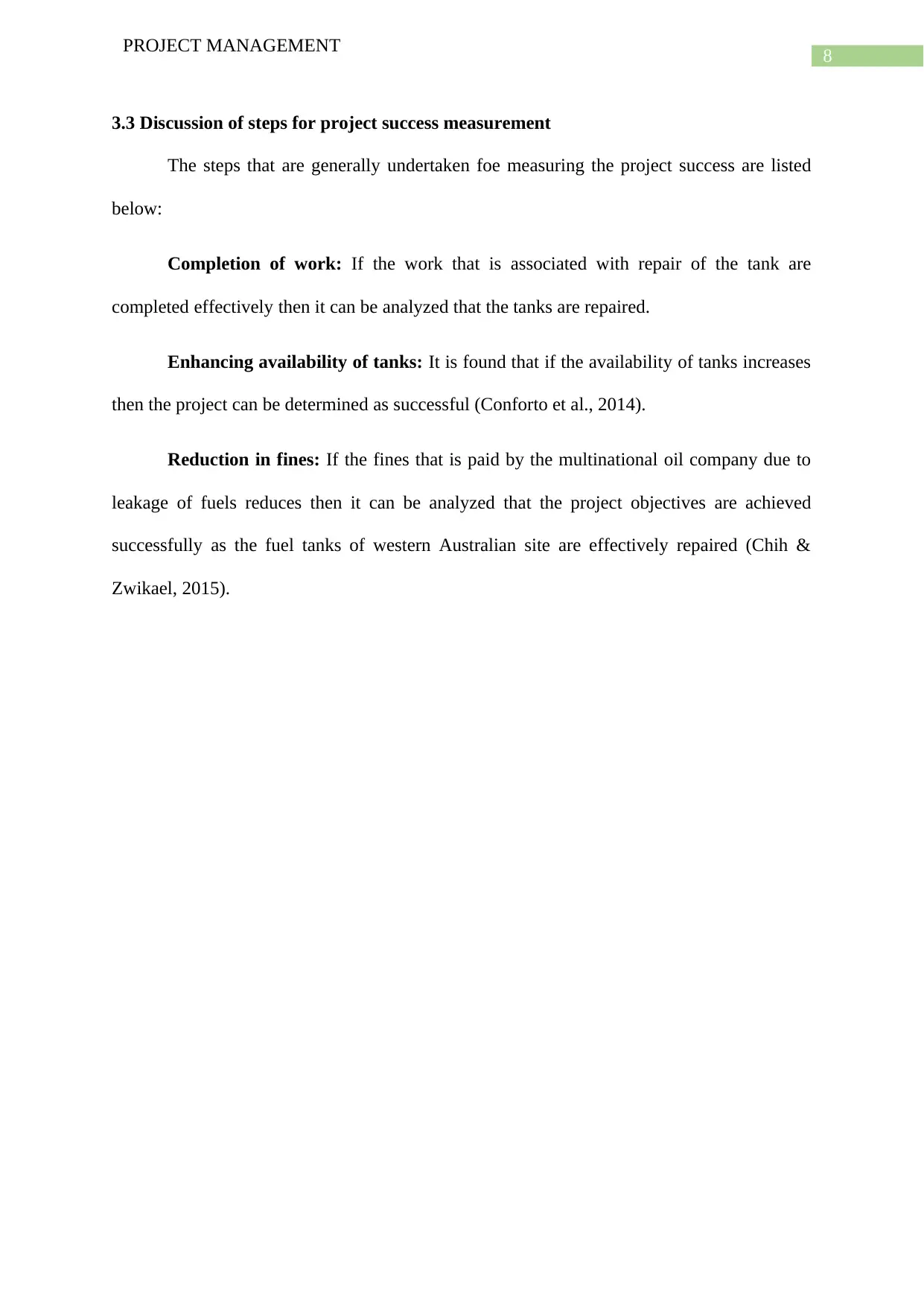
8
PROJECT MANAGEMENT
3.3 Discussion of steps for project success measurement
The steps that are generally undertaken foe measuring the project success are listed
below:
Completion of work: If the work that is associated with repair of the tank are
completed effectively then it can be analyzed that the tanks are repaired.
Enhancing availability of tanks: It is found that if the availability of tanks increases
then the project can be determined as successful (Conforto et al., 2014).
Reduction in fines: If the fines that is paid by the multinational oil company due to
leakage of fuels reduces then it can be analyzed that the project objectives are achieved
successfully as the fuel tanks of western Australian site are effectively repaired (Chih &
Zwikael, 2015).
PROJECT MANAGEMENT
3.3 Discussion of steps for project success measurement
The steps that are generally undertaken foe measuring the project success are listed
below:
Completion of work: If the work that is associated with repair of the tank are
completed effectively then it can be analyzed that the tanks are repaired.
Enhancing availability of tanks: It is found that if the availability of tanks increases
then the project can be determined as successful (Conforto et al., 2014).
Reduction in fines: If the fines that is paid by the multinational oil company due to
leakage of fuels reduces then it can be analyzed that the project objectives are achieved
successfully as the fuel tanks of western Australian site are effectively repaired (Chih &
Zwikael, 2015).
⊘ This is a preview!⊘
Do you want full access?
Subscribe today to unlock all pages.

Trusted by 1+ million students worldwide
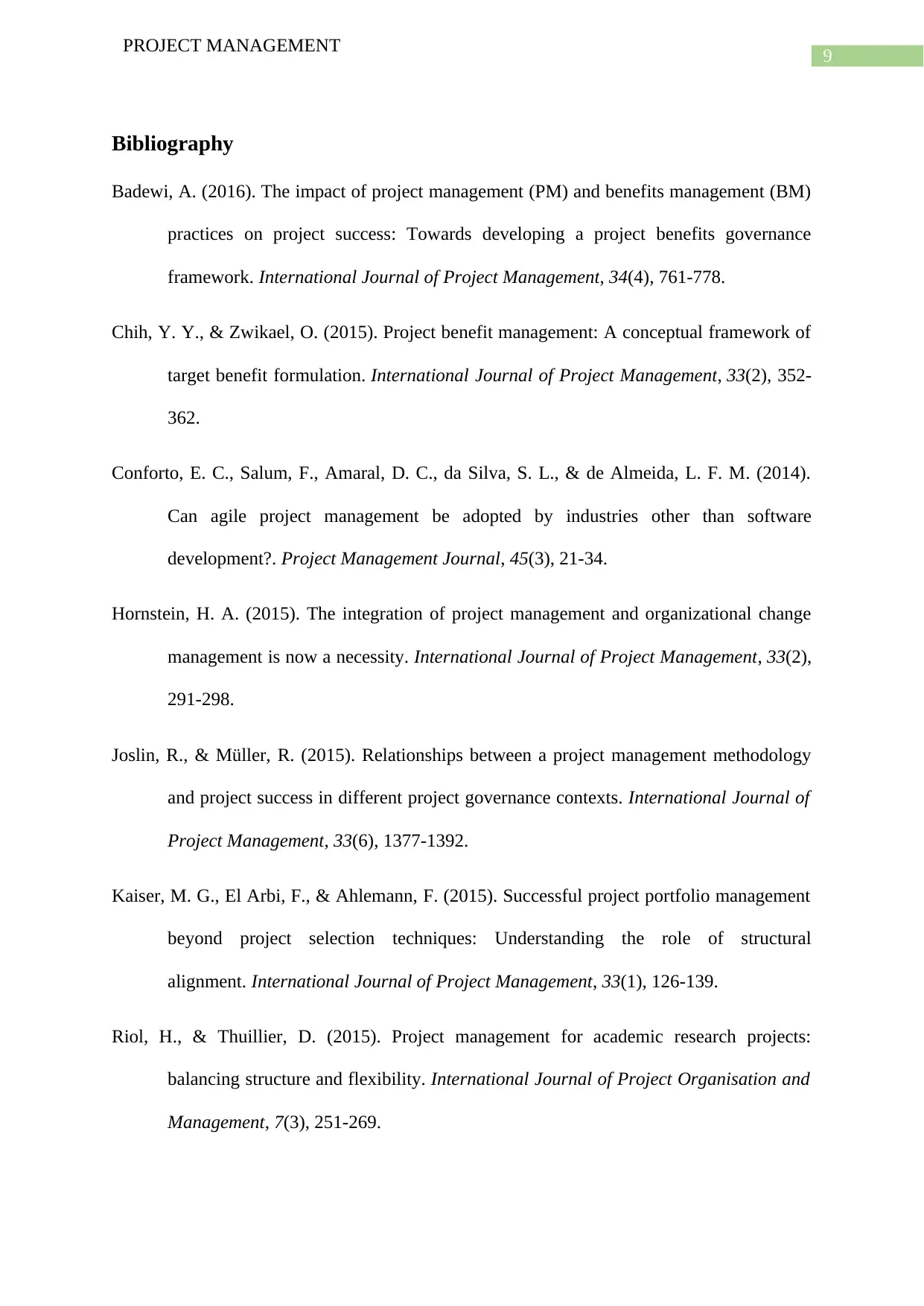
9
PROJECT MANAGEMENT
Bibliography
Badewi, A. (2016). The impact of project management (PM) and benefits management (BM)
practices on project success: Towards developing a project benefits governance
framework. International Journal of Project Management, 34(4), 761-778.
Chih, Y. Y., & Zwikael, O. (2015). Project benefit management: A conceptual framework of
target benefit formulation. International Journal of Project Management, 33(2), 352-
362.
Conforto, E. C., Salum, F., Amaral, D. C., da Silva, S. L., & de Almeida, L. F. M. (2014).
Can agile project management be adopted by industries other than software
development?. Project Management Journal, 45(3), 21-34.
Hornstein, H. A. (2015). The integration of project management and organizational change
management is now a necessity. International Journal of Project Management, 33(2),
291-298.
Joslin, R., & Müller, R. (2015). Relationships between a project management methodology
and project success in different project governance contexts. International Journal of
Project Management, 33(6), 1377-1392.
Kaiser, M. G., El Arbi, F., & Ahlemann, F. (2015). Successful project portfolio management
beyond project selection techniques: Understanding the role of structural
alignment. International Journal of Project Management, 33(1), 126-139.
Riol, H., & Thuillier, D. (2015). Project management for academic research projects:
balancing structure and flexibility. International Journal of Project Organisation and
Management, 7(3), 251-269.
PROJECT MANAGEMENT
Bibliography
Badewi, A. (2016). The impact of project management (PM) and benefits management (BM)
practices on project success: Towards developing a project benefits governance
framework. International Journal of Project Management, 34(4), 761-778.
Chih, Y. Y., & Zwikael, O. (2015). Project benefit management: A conceptual framework of
target benefit formulation. International Journal of Project Management, 33(2), 352-
362.
Conforto, E. C., Salum, F., Amaral, D. C., da Silva, S. L., & de Almeida, L. F. M. (2014).
Can agile project management be adopted by industries other than software
development?. Project Management Journal, 45(3), 21-34.
Hornstein, H. A. (2015). The integration of project management and organizational change
management is now a necessity. International Journal of Project Management, 33(2),
291-298.
Joslin, R., & Müller, R. (2015). Relationships between a project management methodology
and project success in different project governance contexts. International Journal of
Project Management, 33(6), 1377-1392.
Kaiser, M. G., El Arbi, F., & Ahlemann, F. (2015). Successful project portfolio management
beyond project selection techniques: Understanding the role of structural
alignment. International Journal of Project Management, 33(1), 126-139.
Riol, H., & Thuillier, D. (2015). Project management for academic research projects:
balancing structure and flexibility. International Journal of Project Organisation and
Management, 7(3), 251-269.
Paraphrase This Document
Need a fresh take? Get an instant paraphrase of this document with our AI Paraphraser
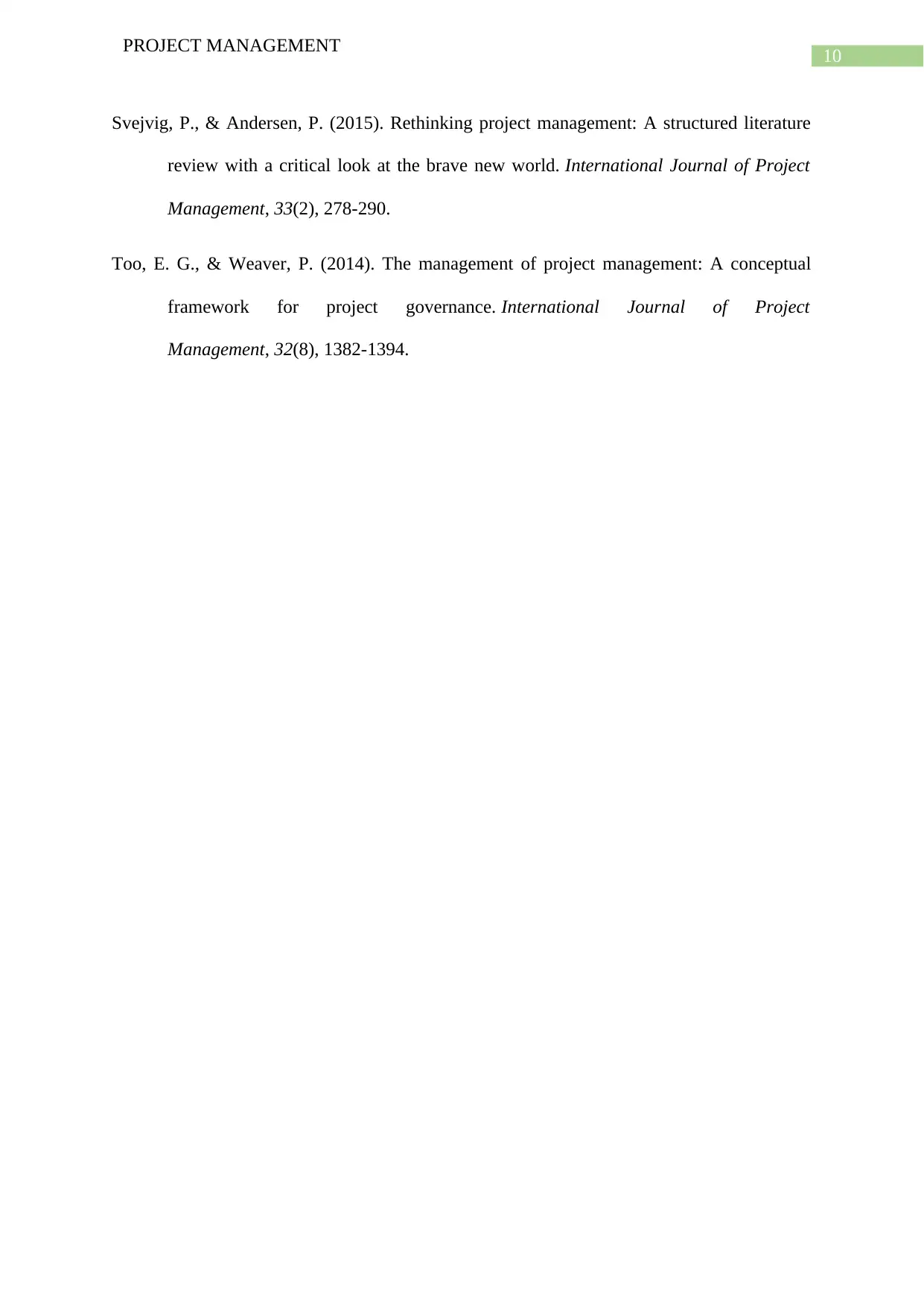
10
PROJECT MANAGEMENT
Svejvig, P., & Andersen, P. (2015). Rethinking project management: A structured literature
review with a critical look at the brave new world. International Journal of Project
Management, 33(2), 278-290.
Too, E. G., & Weaver, P. (2014). The management of project management: A conceptual
framework for project governance. International Journal of Project
Management, 32(8), 1382-1394.
PROJECT MANAGEMENT
Svejvig, P., & Andersen, P. (2015). Rethinking project management: A structured literature
review with a critical look at the brave new world. International Journal of Project
Management, 33(2), 278-290.
Too, E. G., & Weaver, P. (2014). The management of project management: A conceptual
framework for project governance. International Journal of Project
Management, 32(8), 1382-1394.
1 out of 11
Related Documents
Your All-in-One AI-Powered Toolkit for Academic Success.
+13062052269
info@desklib.com
Available 24*7 on WhatsApp / Email
![[object Object]](/_next/static/media/star-bottom.7253800d.svg)
Unlock your academic potential
Copyright © 2020–2025 A2Z Services. All Rights Reserved. Developed and managed by ZUCOL.





